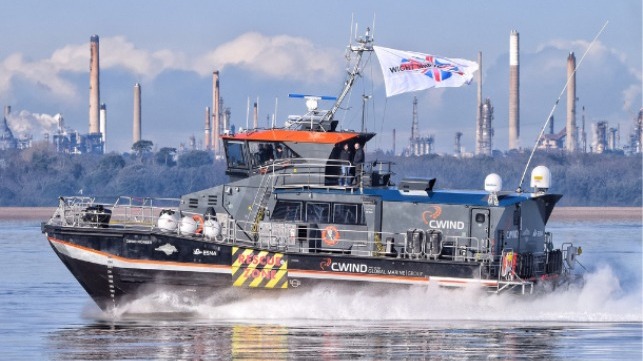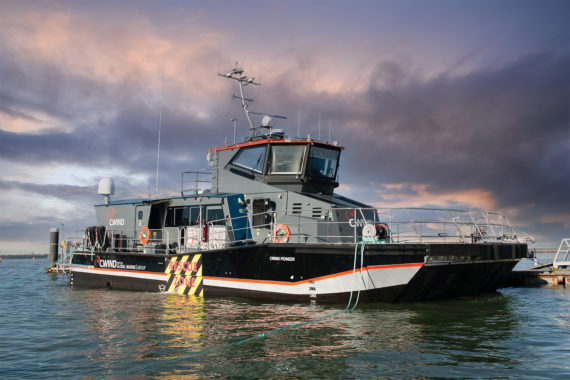Hybrid SES Crew Vessel Lanched to Meet Needs of Offshore Wind Farms

As the offshore wind industry grows, it is requiring advancements in design and new vessels to provide the scope of services required. CWind, a provider of project services and operating crew transfer vessels, is promoting its new vessel as “the world’s first hybrid-powered Surface Effect Ship (SES)." Classed by Bureau Veritas (BV), the CWind Pioneer is designed to provide services to wind farms located further offshore and with its unique features, it will be able to operate more days and provide greater cost efficiency.
Among the unique design features, the vessel has an innovative diesel and electric drivetrain with considerable battery storage and operates on an air cushion, which makes it able to handle more challenging sea conditions. According to the company, the CWind Pioneer can operate at speeds exceeding 43 knots and can transfer up to 24 personnel safely and comfortably even in extreme weather conditions with significant wave heights up to 2 meters, permitting greater operational windows. Its air cushion motion control system provides significant advantages, with smoother and more comfortable conditions on-board and increased operational days offshore.
The hybrid diesel and battery electric power system also enables the vessel to operate purely on battery power alongside or at slow speeds, such as when transiting restricted waterways or on standby in the wind farm. CWind reports that it will help reduce fuel consumption and reduce diesel engine running hours, which will lower CO2 emissions. They also anticipate that the electric hybrid technology will reduce engine wear and consequently maintenance costs. The reduced noise and vibration levels also provide greater comfort for offshore personnel, helping to ensure that they are fit for work when arriving at the offshore wind farms.

“The success of the CWind Pioneer was achieved through years of research and development, resulting in the fastest, safest, and most fuel-efficient CTV on the market,” said Nathanael Allison, Managing Director for CWind, part of the Global Marine Group. “By working together with industry bodies, including Bureau Veritas, our clients, Ørsted, and a range of highly qualified naval architects, ship builders, and marine engineers, we have managed to achieve something truly exceptional. As the CWind Pioneer continues to perform in-field, we will also be able to track a wealth of data to adapt and improve the performance of our hybrid vessels in the future.”
Bureau Veritas was involved with the project from its early design stages, cooperating with the designers, ESNA – a Norwegian Naval Architecture company, and Global Marine Group’s in-house Engineering Department and shipbuilders, Wight Shipyard Co. As the company explains it, the electric hybrid system implementation comes with a good level of complexity that needs to be managed carefully. BV’s notation ‘Electric-Hybrid’ addresses the complexity of these systems, defining requirements for storage, power distribution, control, and instrumentation, as well as tests that must be carried out especially when it relates to power management and critical safety considerations, such as thermal runaway.
The CWind Pioneer is currently being used at the Borssele 1 and 2 offshore wind farms in the Netherlands.
